Introduction
Five Key Points
Common Musician-related Injuries
Conclusion
Canadian Singer/Songwriter Matthew Barber gets some customized treatment from TPHC before the Junos:
The Performance Health Centre kept the musicians and staff in tune at Edgefest. Have a look!
Introduction
Being a professional musician takes considerable dedication. To be able to perform in concert takes several hours of practice per day. Whether they play strings, brass, percussion, or wind instruments, musicians are a special risk group for repetitive strain injuries. Musicians may develop physical conditions directly related to playing their instruments.
How many of you find yourselves rehearsing for hours and hours only to notice pain in your forearms? Or perhaps you find that your hands have become increasingly clumsy or numb. You may even find yourself waking up at night with pain or numbness in your arms and hands, or back and neck. While these problems may be common, they CAN be prevented.
Regular “maintenance” treatment can help prevent these conditions from manifesting Just like athletes, who have strict training programs consisting of various forms of treatment as well as stretches and exercises in order to thwart injury, musicians should also avail themselves of similar preventative care. Don’t wait for an injury to happen. Taking proactive steps now will pay off in the future. So what can a musician do to keep themselves “in tune”?
Five Key Points
- STAY INFORMED: Take time to read up on the various injuries that affect musicians and the treatments that can help to prevent this from occurring (see below)
- TAKE FREQUENT BREAKS: Make sure that you take enough breaks throughout a day while practicing and stretch. This means that you take momentary breaks every 5 to10 minutes and longer breaks every hour. Constant tension and repetitive stress does not allow the body to properly flush out the metabolic waste products that build up over time and this can be very traumatic to the body’s tissues. It is also important to remember that marathon rehearsals will actually decrease the performance. Two shorter rehearsals in a day rather than one long, intense session will be much more beneficial in the long run.
- ERGONOMICS: Ergonomic positioning is all the rage in today’s computer-oriented office scene. As musicians, we face similar postural strain, particularly keyboardists, fretboardists, flute, and string players.
- PAY ATTENTION TO YOUR BODY: This is extremely important. Injuries can often be prevented if you pay attention to what your body is telling you. Pain is actually a signal produced for a reason. So people who take pain killers and then continue doing the activity that caused the pain in the first place, they will definitely end up having some form of injury.
- POSTURE: Proper posture can help prevent injuries. Many of us are not aware of how poor our posture is. How you carry yourself while practicing or simply standing, sitting and even sleeping can have a huge impact on the way you function. Proper posture means your bones are aligned in such a way that there is minimal stress or tension. This proper alignment allows your muscles, joints, and ligaments to work smoothly. Faulty postures essentially put strain on your joints and may compromise your overall health. This will inevitably lead to an inability to perform efficiently or move properly. Chiropractic, Massage Therapy, therapeutic exercises, Yoga and Pilates are all excellent ways of helping you to achieve the optimum posture and ultimately will help you perform at your best.
Common Musician-related Injuries
 |
Carpal Tunnel Syndrome
|
 |
De Quervain’s Tenosynovitis
|
 |
Trigger Finger
|
 |
Cubital Tunnel Syndrome
Musicians with Cubital Tunnel Syndrome tend to present with pain, tenderness, and soreness along the inner part of the elbow and forearm, traveling down to the pinkie side of the hand. Tugging and irritation of the nerve due to repetitive actions involving flexed elbows, such as violin playing and drumming, can damage the sensitive nerves. The most frequent complaint, however, is of paresthesias (numbness and tingling) in the ring and small fingers, which often is related to posture, repetitive movements, and hand positioning (commonly seen in string players). Patients often note they have “weak or clumsy hands”. |
Conclusion
There is no question that musicians are a special group of professionals that can inherit many of the same injuries that a common computer user may develop. Unfortunately, some musicians assume that their painful condition is normal and find ways to mask the effects of their developing injury. This is partly due to a performance culture in which there is a long standing philosophy that the “show must go on” and partly due to a common concern among professional musicians of being labeled as a musician with an injury.
Fortunately, there are ways to prevent these sometimes debilitating injuries from occurring. Chiropractic, Massage Therapy, Acupuncture etc. are just a few therapies proven to help eliminate and/or prevent such conditions from manifesting. Taking pro-active steps now, before injury occurs, will ensure not only the health of your body but your long lasting career as a professional musician.
The Performance Health Centre… “Helping you to Perform at your Best!”
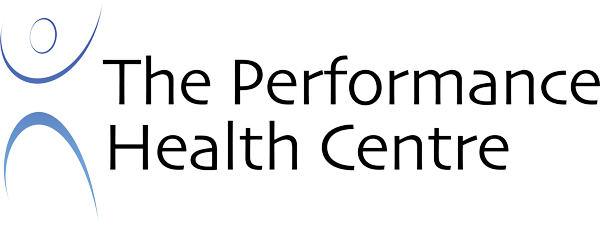
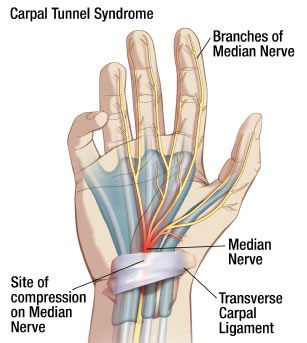 Carpal Tunnel Syndrome is a condition where there is excessive pressure on the median nerve. This can be caused by swelling and/or thickening of the transverse carpal ligament, which forms the roof of the carpal tunnel located in the wrist. Overuse and repetitive motions, common with musicians, can often cause symptoms of Carpal Tunnel Syndrome including pain, numbness or tingling in the thumb, index, middle and part of the ring finger.
Carpal Tunnel Syndrome is a condition where there is excessive pressure on the median nerve. This can be caused by swelling and/or thickening of the transverse carpal ligament, which forms the roof of the carpal tunnel located in the wrist. Overuse and repetitive motions, common with musicians, can often cause symptoms of Carpal Tunnel Syndrome including pain, numbness or tingling in the thumb, index, middle and part of the ring finger.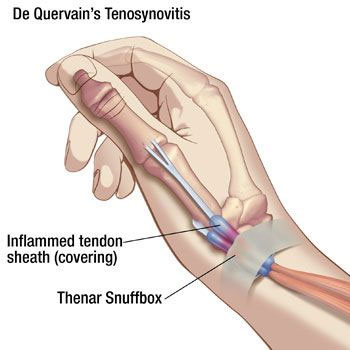 De Quervain’s tenosynovitis is a repetitive strain injury that causes pain at the wrist and forearm just above the thumb. Repetitive hand and thumb motions, commonly seen among musicians, can lead to inflammation which hampers the smooth gliding action of the tendons. Initially, symptoms may consist of soreness in the forearm near the thumb. If left untreated, pain may spread up the forearm or into the wrist and thumb.
De Quervain’s tenosynovitis is a repetitive strain injury that causes pain at the wrist and forearm just above the thumb. Repetitive hand and thumb motions, commonly seen among musicians, can lead to inflammation which hampers the smooth gliding action of the tendons. Initially, symptoms may consist of soreness in the forearm near the thumb. If left untreated, pain may spread up the forearm or into the wrist and thumb.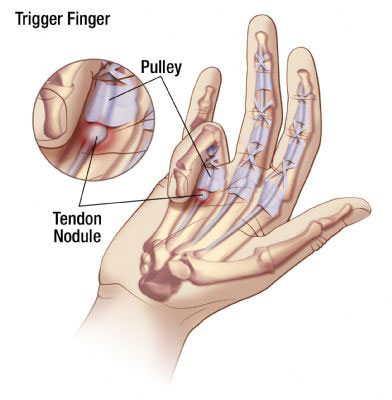 Trigger Finger is an inflammation of the tendon(s) that flex or bend the finger(s). The tendons pass through a series of pulleys that hold the tendons close to the finger (see below). Anything that reduces and/or compresses the space inside the tendon sheath can cause the tendon to get stuck as it goes through the pulley. Inflammation and/or trauma may cause the tendon sheath to get caught as the finger moves from a flexed position into extension. The most common symptom of Trigger Finger is a clicking or locking of the fingers when attempting to straighten them from a flexed position. In severe cases, the finger needs to be passively (using the other hand) straightened. Trigger finger is commonly seen in piano, trumpet and guitar players.
Trigger Finger is an inflammation of the tendon(s) that flex or bend the finger(s). The tendons pass through a series of pulleys that hold the tendons close to the finger (see below). Anything that reduces and/or compresses the space inside the tendon sheath can cause the tendon to get stuck as it goes through the pulley. Inflammation and/or trauma may cause the tendon sheath to get caught as the finger moves from a flexed position into extension. The most common symptom of Trigger Finger is a clicking or locking of the fingers when attempting to straighten them from a flexed position. In severe cases, the finger needs to be passively (using the other hand) straightened. Trigger finger is commonly seen in piano, trumpet and guitar players.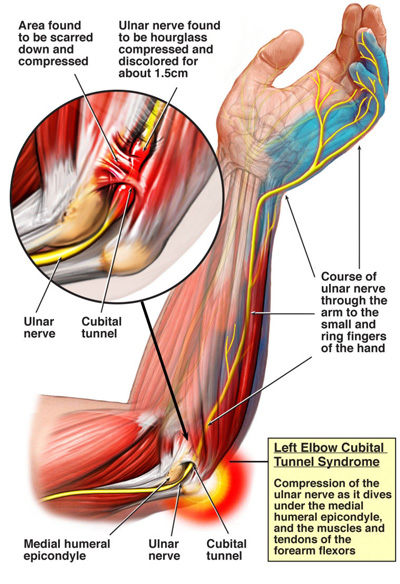 Cubital Tunnel Syndrome is associated with compression of the ulnar nerve, which is about the size of a pencil and controls the muscles for grip strength and feeling in the little, ring, and often the middle fingers. (See image)
Cubital Tunnel Syndrome is associated with compression of the ulnar nerve, which is about the size of a pencil and controls the muscles for grip strength and feeling in the little, ring, and often the middle fingers. (See image)

